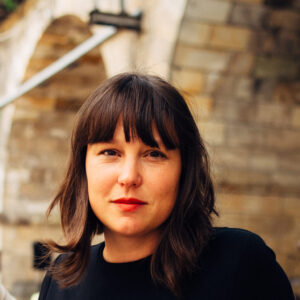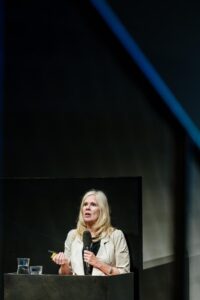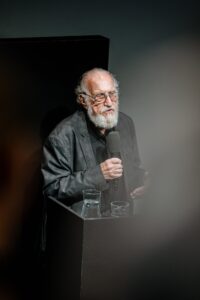Author: Lauren Goshinski
Across the disciplines of urban planning and placemaking, international exchange serves as a catalyst for both personal and collective innovation. This was precisely the case for Yvette Vašourková, Ph.D., co-founder of the CCEA MOBA Centre for Central European Architecture, who was awarded a Fulbright fellowship to join Pratt Institute’s Urban Placemaking and Management (UPM) program for the 2023-2024 academic year. Her time in New York City not only expanded her understanding of community engagement, it also led to her creation of “HyperLocal”, a summer 2024 symposia hosted in her home city of Prague, Czech Republic, that fostered an invaluable knowledge exchange between local urbanists and professors from Pratt’s Graduate Center for Planning and the Environment.
Yvette Vašourková’s Fulbright Journey
Vašourková chose Pratt’s UPM program for its unique focus on community engagement within the public realm. During her year-long research, she was impressed by the breadth of support government agencies, community-based organizations, non-profits, and private sector initiatives provide to small-scale businesses, cultural initiatives, and local communities in New York City. “I was surprised to discover that the roots of these actions, such as the emphasis on social justice and environmental issues, have a strong tradition dating back to the 60s and 70s in New York City,” Vašourková noted. She observed how New York City’s landscape is influenced by and has integrated bottom-up approaches to urban planning, where local communities lead initiatives, while cities like Prague and Brno have typically relied on top-down approaches driven by city authorities. The ideal, she suggests, would be a balanced method that integrates both strategies.

Adaptive reuse of urban infrastructure drove Vašourková’s research. “I focused on transport infrastructure and its potential for community activation, investigating how neglected spaces around transportation structures could be repurposed to benefit local communities. I learned about innovative projects such as Gotham Park under the Brooklyn Bridge, initiated by the local Chinese community, and the hidden potential of the Queensway. I was also impressed by the High Line Network, which unites similar projects across the USA. Besides gathering projects that transform traffic infrastructures, the alliance also tries to highlight the negative gentrification effects of the High Line project. For example, the 11th Street Bridge Park project in Washington aims to avoid gentrification by stabilizing property values in the surrounding area; let’s see how successful they will be.”


Under Brooklyn Bridge, Gotham Park, NYC, Yvette Vasourkova, 2023-2024
“These engineering structures, a legacy from the latter half of the 20th century, are aging and will soon require complex renovations, as seen with the Brooklyn-Queens Expressway (BQE). By approaching these structures not merely as transport corridors but as spaces for community interaction, we can transform them and their surroundings into more vibrant and liveable places.” This historical depth and commitment to community-oriented urban planning inspired her to bring these lessons back to the Czech Republic.

Bridging HyperLocal Knowledge
Credit: HyperLocal symposia site tours, Prague & Brno, 2024
Upon returning to Prague, Vašourková organized the HyperLocal symposia, a series of site tours, discussions, and presentations that brought together GCPE faculty members with Czech practitioners, academics, and representatives from local government agencies. GCPE faculty included department Chair Eve Baron, Professor Emeritus Ron Shiffman, UPM Academic Director David Burney, Yvette Shifftman, and Eva Hanhardt. This initiative served as a platform for exchanging ideas and practices between New York City and Prague, with a particular focus on community engagement and cultural placemaking.

HyperLocal symposia,
Prague,
Yvette Vašourková, 2024
Eve Baron, Chair of GCPE and Academic Director of Pratt’s Urban and Community Planning program, emphasized the importance of this exchange. “The relationship [Vašourková] established led to the exchange with fellow professionals and academics in Prague and Brno, and it lives on as we continue a dialogue with the Mayor’s Office in Prague on the production of a handbook on community engagement.”
The exchange highlighted several critical insights and experiences for both New York and Prague. One of the standout moments was a visit to CAMP, the Center for Architecture and Metropolitan Planning in Prague. “We were particularly impressed by the sheer physical beauty of the cities,” reflected Eve Baron “but especially by CAMP. It’s like an active, open invitation to the public to spend time with government agencies—we need this in New York!”
David Burney, UPM Academic Director, echoed these sentiments, stressing the value of intellectual exchange in emerging disciplines like placemaking. “It was a wonderful opportunity to host Yvette Vašourková as our Fulbright scholar. The exchange allowed us to see the work accomplished in those cities and share ideas that will inform policy and practice in both New York and the Czech Republic.”

at HyperLocal symposia,
Prague,
Yvette Vašourková, 2024
Professor Emeritus, Ron Shiffman, highlighted the importance of such exchanges in exposing both visitors and hosts to new ideas, strategies, and spaces that could advance community-driven urban planning. Reflecting on his visit to CAMP, he said, “The experience challenges both to pursue their professional obligations with new vigor and sharper insight. CAMP is an idea worth adapting and replicating.”
Shiffman also underscored the value of learning from international traditions, particularly the use of planning and architectural competitions as a prerequisite for development—a practice deeply rooted in European planning culture. This approach, he suggested, could significantly benefit metropolitan areas like New York.


(L) David Burney (R) Yvette Shiffman present at HyperLocal symposia, Prague, Yvette Vašourková, 2024


Credit: (L) Ron Shiffman (R) Eva Hanhardt present at HyperLocal symposia, Prague, Yvette Vašourková, 2024
About The Fulbright Program
The Fulbright Program, established in 1946, is one of the United States’ most prestigious cultural exchange initiatives, aiming to improve intercultural relations and diplomacy through the exchange of knowledge and skills. The program annually awards approximately 8,000 grants, supporting students, scholars, and professionals in their endeavors to study, research, and teach abroad. Vašourková’s participation in this program exemplifies its impact on fostering global collaboration and enhancing urban planning practices.
Future Directions for Exchange

Looking ahead, Vašourková envisions continued collaboration between Pratt Institute and academic institutions in the Czech Republic. She proposes joint workshops and projects that could further enrich the exchange of ideas and practices between the two regions. “Establishing a summer or spring project in the Czech Republic, working together with local municipalities and non-profit organizations, would be a promising start,” she suggests.
Yvette Vašourková’s Fulbright experience and the subsequent HyperLocal symposia underscore the catalytic impact of international exchange and collaboration, enriching practitioners work in both cities and also setting the stage for ongoing dialogue and future projects. As cities worldwide grapple with the challenges of creating livable, sustainable environments, such knowledge exchanges offer a path forward, blending local insights with global perspectives.




